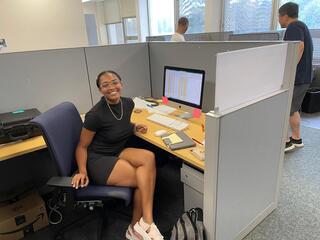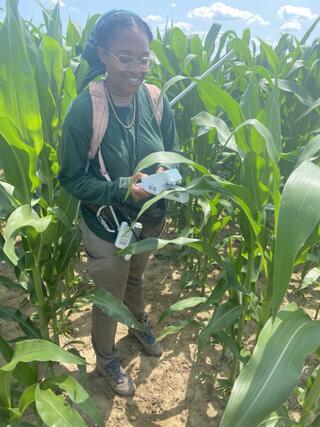Jules Seay


Hey y’all, I’m Jules, and this summer I worked with the Great Lakes Bioenergy Research Center studying plant physiology. I worked in the LEES Lab under Dr. Jiquan Chen exploring the stomatal conductance of bioenergy crops, more specifically corn and switchgrass. Stomatal conductance is the rate of gas exchange between a plant leaf and the atmosphere, and we used this measure as a proxy for the potential intake or release of carbon dioxide from the plant leaves of corn and switchgrass. The higher the stomatal conductance, the more gas is being sequestered from the atmosphere and into the leaf for photosynthesis which is what we want. The objective of this research was to do a comparison of the stomatal conductance and land use histories of corn and switchgrass. The stomatal conductance of the two crops is being compared to explore the potential release or uptake of carbon dioxide to understand which crop may contribute the least to atmospheric carbon dioxide and ultimately climate change. Looking at potential land uses is also important because this will influence how the two crops sequester carbon, grow and undergo photosynthesis. One to two times a week, I drove to the Kellogg Biological Station’s Scale–Up Sites and measured their stomatal conductance using a Li-600. Along with stomatal conductance, I also measured the plants’ foliar nitrogen content and their leaf area index to see if there’s any relationship with these biophysical characteristics as well. I collected these data points on four plots that were several hectares big which was quite an adventure when the corn grew over six feet tall. Once all of the data was collected, my lab conducted an ANOVA test to see if there was significance in the variation of the stomatal conductance between the corn and switchgrass. When I wasn’t out in the fields, I got to talk to researchers from the University of Michigan and NASA to see other ways that bioenergy is being researched.
Aside from fieldwork, I was so excited to befriend everyone in my program and get to go on all kinds of adventures with one. As someone who’s never been to Michigan, I wanted to see as much as I could. One day we had a field trip to Detroit with students from other labs and programs to go to the Detroit Zoo, the Detroit Art Institute, and the aquatic border between Michigan and Canada. I got to see Canada for the first time. Coming to Michigan I knew that I had to see Lake Michigan, and I was so happy that I got to see it and swim in it. I didn’t know that Lake Michigan had its own tidal waves which were fun to see. East Lansing also had a lot of restaurants that I got to try for the first time, and all of the food was 10/10. I love the research community here, so much that I plan on applying to graduate school at Michigan State. Wish me luck!